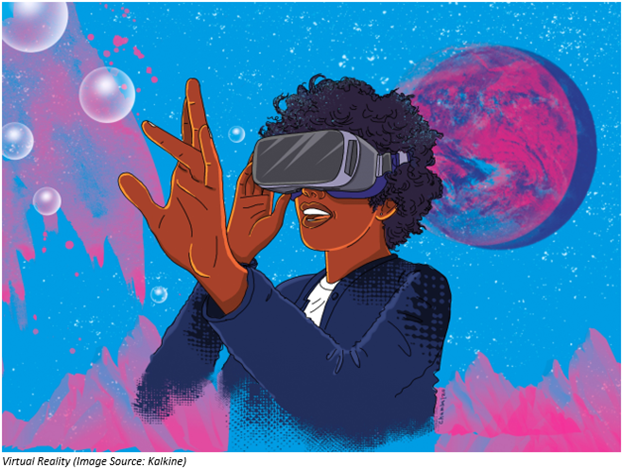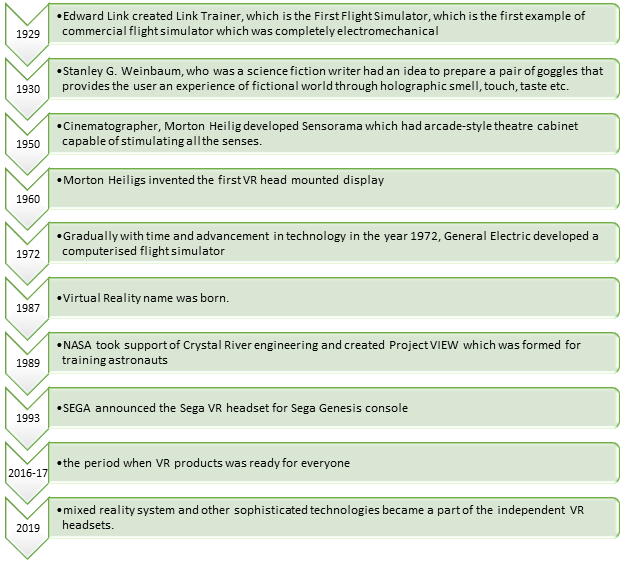What is Virtual Reality?
Virtual Reality, or VR, comprises of two words ‘virtual’ and ‘reality’, which together essentially mean ‘near-reality’. We interpret and understand our surrounding environment using our senses like smell, see, touch, feel and taste. Also, we use our perception to understand our surroundings. Our sensory organs collect these data, which is then processed by our brain, and then the body acts accordingly and interprets things surrounding us.
VR helps us to provide the same experience even though we might not be present at that location.

Let us understand it through an example. We all have seen 3-dimensional (3D) movies using specific glasses, known as 3D glasses. Suppose you are watching a movie where there is a scene near the seashore with high tides – the 3D glasses will make you believe that you are actually sitting at the seashore and able to feel the sound of the rising tides, even though in reality, you are still in the movie theatre. This is an example of Virtual Reality.
Hence, we can define Virtual Reality as the application of computer technology to form a simulated ambience. Virtual Reality helps people to communicate within a 3D environment with the help of technological devices like 3D goggles, VR headsets and so on.
INTERESTING READ: Shedding light on another World within sight - Virtual Reality
How does Virtual Reality work?
At present, VR headsets are used for experiencing the 3D environment. The VR headset is connected to either a personal computer, console, or smartphone via HDMI cable. The headset can also be connected to other devices like head and hand tracking, controllers, voice inputs.
Once the process of establishing a connection is made between the headset and any of the devices mentioned above, the following happens:
- There may be one to two screens per eye that get two feeds. There are autofocus lenses that are placed between the screen and the eyes. These lenses can be adjusted as per the eye movement and positioning.
- These lenses can be used for focusing and reshaping for each eye. Further, a 2D image can be tilted for generating a 3D image.
History of Virtual Reality
What to expect from VR in the Future?
Virtual Reality has a broad scope, and big players such as Google, Microsoft and Samsung have been quite active in this space. Virtual Reality started gaining grounds in 2016, and there was an increase in the number of VR games, applications, and software to provide the user with real-life experience. The combination of graphics, sound and an interesting story-line make the experience outstanding.
In the upcoming period, VR will have a substantial impact on various industries. Let us look at some of the industries where we can expect a growth in VR applications.
- Healthcare: VR has made its entry in the healthcare industry as it helps doctors during operational procedures, provide medical training, or cure stress or any medical emergency.
- Tourism: People who love travelling and exploring new destinations can derive benefits from the usage of VR technology. For example, if an individual wants to see a location which he/she has never visited, VR could be a great help. By using VR technology, the person can have the experience of some tourist spots before travelling to that place. VR is capable of providing a 360-degree view of hotels, destinations.
- Future Video Conferencing: With a change in the traditional working style, those days are not far that we see that video conferencing takes place via VR technology. The participants in the meeting would feel as if they are sitting in a conference room. They would be able to see the whole room via a 360-degree immersive content using a VR headset.
- Training and development: Training and development is another field where we might see VR play an essential role. Through the technology, students could be more engaged. Instead of explaining the theory, students would be able to actually experience these theories.
- Recruitment: For recruitment, companies might start the recruitment process using VR in the future. It will have multiple benefits like:
- Usage of VR technology would reflect how the companies have started accepting the new technologies.
- It would also reflect how the company is making use of the technology to benefit not only itself but also its people.
- The recruiter can also understand the body language of the candidate based on the situation.
- Sports: In the fields of sports, VR can prove to be useful when the coach trains his/her players across a range of sports activities. Players and the coach can improve their efficiency and better understand the strategies of the game or the opponent each time. It could also be beneficial for enhancing cognitive abilities when a player gets injured.
What is the Probable Size of the Virtual Reality Market?
As highlighted above, Virtual Reality has massive potential and could be a big market with a wide range of applications across various industries.
Market experts believe that the market size of VR in 2020 is around US$6 billion, and they believe this figure could cross the US$20 billion-mark by 2025. The CAGR of this market is expected to growth at ~27%. The availability of VR devices at affordable prices is the primary reason for VR’s anticipated growth.
What are the Potential Drivers of Virtual Reality Market?
- Post the end of the COVID-19 era, the demand for head-mounted displays (HMDs) would increase in the gaming and entertainment sector. It would drive this industry.
- The technology might experience restraint because of display latency and energy consumption, which might impact the performance of the devices.
- VR has a huge opportunity with the increase in its usage in defense, training, and medical purposes, among others.
- There are existing challenges of developing user-friendly devices which allow the user to easily navigate and communicate with the objects in the virtual world.

 Please wait processing your request...
Please wait processing your request...